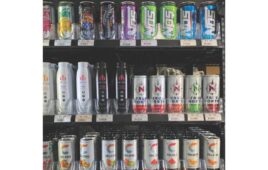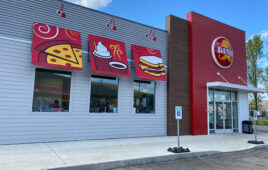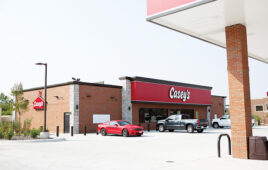 Choice Market isn’t letting a pandemic impede its plans for 2020. If anything, COVID-19 has increased consumer demand for seamless delivery of convenience products, fresh prepared foods and autonomous, contactless checkout — the chain’s top initiatives.
Choice Market isn’t letting a pandemic impede its plans for 2020. If anything, COVID-19 has increased consumer demand for seamless delivery of convenience products, fresh prepared foods and autonomous, contactless checkout — the chain’s top initiatives.
With two locations in Denver, and two more set to debut this year, Choice Market is making a name for itself by leading with an upscale fresh menu and cutting-edge technological advancements.
When its third c-store opens this June, Choice will launch its second-generation design and omnichannel platform that updates its mobile app and e-commerce website to allow customers to order not only prepared foods, but the c-store chain’s entire SKU selection of convenience products for delivery.
The third location will feature electric vehicle (EV) charging, a bike share, a new interior layout and a revamp of Choice’s prepared-food ordering kiosks.
“One of the big things we’re working on is a full digital transformation for our app, e-commerce website and in-store kiosk,” said Mike Fogarty, owner and founder of Choice Market. All are set to offer a uniform experience for customers, so shoppers receive the same experience regardless of how they shop.

With the opening of its third site, Choice is adding delivery to its white-label mobile app, adding a new in-app loyalty program and presenting a unfied interface from website to app to kiosk.
But Choice has an even bigger transformation up its sleeve for the opening of its fourth c-store, scheduled for the second half of 2020. It has joined forces with a strategic tech partner to pilot “full-vision self-checkout” at its fourth store, which it also plans to extend to future sites. The fully autonomous checkout experience will be driven by artificial intelligence (AI) vision-based technology that tracks products as customers select them.
A Hybrid Model
Denver-based Choice Market opened its first location in downtown Denver in October 2017 and launched its second store in 2019. The omnichannel convenience store features the operating hours, transaction times and store size of a traditional convenience store but a product selection more traditionally found at a natural grocery or fast-casual restaurant.
An omnichannel approach is “quintessential to the brand,” Fogarty said. True to the Choice name, it gives customers options — whether that’s order-ahead, delivery or kiosk ordering.
“Today’s digitally enabled customers are ordering at-home delivery more, but they’re also living and working in urban areas, so walkability and proximity are key considerations,” Fogarty said.
Fogarty’s ideas about what a c-store could be were influenced by his childhood experiences growing up outside of Philadelphia, home of Wawa, which is headquarted nearby in Wawa, Pa. “They were one of the first true innovators within the c-store space with full deli and kiosk ordering, open 24 hours and a step above your traditional c-store,” Fogarty said.

Prepared food represents 50% of Choice’s sales. The convenience store is a hybrid model that positions itself at the intersection of fast-casual restaurants, small-format natural grocery and convenience.
Fogarty was further inspired by Europe’s small-format grocery stores, specifically in Barcelona, where he lived for eight months after college.
“I found myself going to them almost every day and getting three or four things at a time. I really enjoy that style of shopping and felt that there was gap here in the U.S. market,” he said.
Ten years later, Fogarty saw his opportunity to innovate in the c-store market. At the time, he was working for a large consumer packaged goods company in the better-for-you organic space. The brand was struggling to find footing in the c-store channel with organic, natural products, and Fogarty knew he could fill the niche.
Enter Choice Market, which Fogarty describes as a “hybrid model between fast-casual restaurants, small-format natural grocery and a convenience store.”
Food Focus
One key differentiator for Choice is its focus on prepared food, which represents 50% of its sales. “We’re as much a restaurant as we are a market,” Fogarty said.
“We have a full scratch kitchen (where everything is produced from raw ingredients), and we’re cooking with products like organic produce and greens that are grown in an aeroponic farm about a quarter mile away,” Fogarty said. “All of our proteins are antibiotic free, hormone free. All of our breads are baked daily by local bakeries.”
Choice reduces waste by cooking with products it’s also selling in the c-store. Carrying produce has traditionally been a challenge for c-stores, he pointed out. “They can’t really get through a full case of (produce) before it spoils, whereas our model allows us to really utilize that product on both sides of the house.”

Choice Market features 30-40 SKUs of organic produce and raw proteins. Choice’s model uses the same products and produce it sells in stores in its foodservice offering, which reduces waste.
The Choice menu includes breakfast items such as açaí bowls, organic oatmeal and its Colorado Quinoa bowl, which features a sunny-side-up egg, wilted chard and red chimichurri. Lunch and dinner options include sandwiches, salad bowls and smoothies. The bowls consist of a base such as quinoa or lentils, plus a protein, organic vegetable and a sauce for around $12 to $14.
Choice Market’s core customer is the urban millennial. They may or may not have a car. Some may have families, but smaller families compared to the boomer generation.
“People are having fewer kids,” he said. “They’re driving less. They’re making more frequent stops at the store. They’re increasingly choosing prepared foods over cooking at home just because the convenience factor is there.”
He sees Choice as filling the needs of this urban millennial shopper — a niche overlooked by most c-stores and even grocery stores today.
To best serve its core customer, Choice recently partnered with Erik Oberholtzer, founder of California restaurant chain Tender Greens, to overhaul its menu, reducing the number of offerings and increasing the overall quality of its items.
“We have a very clear food philosophy and food promise in terms of what we will and will not cook with, and just really honed in on that for our menu to be more efficient in the kitchen,” Fogarty noted.

Denver-based Choice Market operates two c-stores and is set to open its third location in June and a fourth location later this year that will feature autonomous checkout using vision-based technology.
Choice is also committed to a hyper-local supply chain, which extends to its coffee business. It works with Denver-based Method Roasters.
Choice’s commitment to quality extends to beverages. It offers 40 different SKUs of bottled kombucha, and has kombucha and nitro coffee on tap. It also features private-label cold-pressed juices and a range of sparkling waters, including CBD sparking water, which has been a strong seller.
Designing for Tomorrow
Choice Market’s first two locations feature a minimalist yet urban and modern design that is atypical of a traditional c-store.
“It pulls a little bit from that kind of European, almost Scandinavian, style, with light woods, dark metals and concrete floors,” Fogarty said. The result is an industrial, urban and clean vibe.
With its third and fourth locations, the chain is working with a retail design firm to solidify an updated design that will be implemented across all future stores. “You’ll see a slight change in some of the future locations, but it’ll still be reminiscent of our initial location,” he said.
Choice is also testing different sized formats. Its first location measured 2,500 square feet in an urban area, while its fourth site is planned for a high-density, residential neighborhood and set to feature a larger footprint. Fogarty anticipates that as the chain grows, its stores will measure between 2,500 and 4,000 square feet. “You lose the convenience factor as you get bigger,” he noted.
The c-stores feature restaurant-style seating, a section with made-from-scratch, grab-and-go foods, a soup station, an empanada station and an entire CBD section. They also feature 30-40 SKUs of organic produce and raw proteins, such as antibiotic-free chicken breasts.
“We’re kind of crossing over multiple models and definitely have some sections that you wouldn’t find at a regular c-store,” Fogarty said.
As the chain rolls out EV charging with the launch of its third site, it’s considering how that will change the customer’s shopping needs.

Choice’s vision for the future includes a range of micro markets, vending machines and fully autonomous stores.
“In the future, it’s going to take 20-30 minutes to fully charge a car. So you have to offer an experience,” Fogarty said. “You have to offer a product selection and design that people want to hang out in, either grabbing a meal or some groceries, or hanging out on Wi-Fi.”
With the opening of its third site, Choice will also be introducing its own fleet of electric vehicles that will be charged on-site. Choice employees will use the vehicles to deliver food and groceries to customers, as Choice adds delivery to its white-label mobile app and commits to handling the last mile in-house. As it continues its goal of offering one unified experience managed by Choice, it will also include real-time GPS updates for customers.
While Choice already offers online ordering for pickup as well as delivery using third-party vendors, it currently uses “all different systems, and it’s very disparate,” Fogarty said.
While Choice will continue to use some third-party delivery services, Fogarty pointed out that such services were built primarily for restaurants. “We’re carrying 3,000-4,000 SKUs, so it’s not necessarily the best fit,” he said.
Choice is also rolling out a new in-app loyalty program. The points-based program awards one point for every dollar spent. Customers can use the points to purchase rewards — such as $5 off for every $100 spent. Loyalty customers will receive free delivery through the app for the first month of membership and free coffee on their birthday.

Choice is committed to a hyper-local supply chain and providing healthy, natural and organic items.
“We see an opportunity to really reduce our fees, to improve customer loyalty and retention, to increase the data that we have, and ultimately provide a better experience and control that experience a little bit more,” Fogarty said. “And most importantly, offer the entire store for delivery, including alcohol.”
“We will be the first retailer to offer high-quality groceries, prepared food, home and health and alcohol all in one convenient transaction (for delivery), which we think is really going to be a game changer,” he added.
“At the end of the day, we’re not in the business of just investing in technology just to pump up valuations or to be like a novelty type thing,” Fogarty said. “It has to have a real use case and solve a real problem.”
That’s been a big consideration in deciding to introduce frictionless checkout to its fourth site when it opens in the back half of 2020. A lot of Choice products don’t have a UPC or bar codes, including the chain’s bagels, produce, empanadas and coffee. For Choice, allowing customers to check in once, and then have the cameras and systems handle the rest, will make the experience more convenient for customers and help alleviate the UPC challenge for Choice, as well.

While Choice Market’s seating area is closed during COVID-19, the c-stores normally feature restaurant-style seating. As it launches electric vehicle charging, it’s designing a space where customers want to hang out and enjoy made-from-scratch, grab-and-go foods or Wi-Fi.
As Choice continues to plan for the future, it is viewing the c-store landscape “holistically,” which includes considering how mobility is going to change over the next five to 10 years. Its ultimate vision for the future includes a range of micro markets, vending machines and fully autonomous stores.
“The most important thing in people’s lives is their time,” Fogarty said. “If we can continue to reduce that friction, reduce that stress, we will; and so certainly frictionless is on our roadmap.”
Fogarty sees Choice continuing to offer a “physical retail anchor” that supports last-mile distribution for delivery and pickup, and meeting customers where they’re at, whether that’s online, in-app or in a micro-market setting.
“I think the brand new platform is going to be truly revolutionary, at least for our customers, allowing them to have one single experience, whether it be on the app or on the website or on our kiosks and tied to one single loyalty program,” Fogarty said. “We’re excited to continue to grow and offer our customers new, convenient ways to access fresh, awesome food.”




